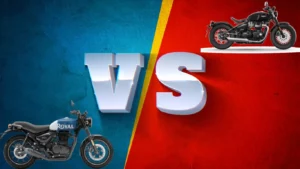Modern motorcyclists want gear that’s safe, comfortable, and digitally connected. Bluetooth-enabled motorcycle helmets have transformed biking. This guide will explain why a Bluetooth motorcycle helmet is essential in 2023 and its many benefits.
Motorcycle gear is essential for style and safety. One of the most important parts of your gear, the helmet, protects your head in an accident. Recent helmet technology has added features beyond protection. Bluetooth technology is popular in 2023.
Why is a Bluetooth-enabled motorcycle helmet essential in 2023?
Motorcycle helmets with Bluetooth are no longer a luxury but a necessity in our increasingly connected world. Here’s why:
- Enhanced Communication: A Bluetooth-enabled helmet allows the rider to communicate hands-free with fellow riders or receive phone calls. It eliminates the need to pull over to answer calls or look at the phone for GPS directions, hence ensuring safer rides.
- Entertainment: Motorcycle rides, especially long ones, can get monotonous. Bluetooth helmets can connect to your smartphone, letting you listen to your favorite music or podcasts, making the ride more enjoyable.
- Real-time Navigation: Rather than constantly looking down at your GPS device or smartphone, audio directions can be streamed right to your helmet. It simplifies navigation and reduces road distractions.
- Emergency Features: Some Bluetooth helmets come with a built-in SOS feature. These helmets can automatically notify the nearest emergency centre after an accident, saving lives.
Benefits of using A Motorcycle Helmet with Bluetooth Technology
Here are some significant benefits of using a motorcycle helmet with Bluetooth technology:
- One of the significant advantages of Bluetooth helmets is that they promote hands-free operation, contributing to safer rides. You can answer calls, change music, and receive GPS instructions without taking your hands off the handlebars.
- If you’re traveling in a group, Bluetooth helmets allow for seamless intercom communication up to a certain range. This feature is great for coordinating with other riders or just for friendly banter on the road.
- With features like music and call answering, a Bluetooth helmet adds a level of comfort to your ride. Long journeys can be more relaxing and enjoyable, helping to reduce fatigue.
- With a Bluetooth helmet, there’s no need for extra devices or wires that could get tangled or lost. Everything is integrated into the helmet, offering a cleaner setup and easier usage.
A Bluetooth motorcycle helmet is an intelligent investment in 2023, combining safety and convenience with the benefits of modern technology. It’s about picking a helmet that protects your head and improves your ride.
Key Features to Consider in a Bluetooth Motorcycle Helmet
You can’t just buy any Bluetooth motorcycle helmet. Instead, it’s about finding the right helmet that combines safety, comfort, and advanced Bluetooth features effectively. Important features include:
1. Helmet Safety Standards and Certification
Helmets protect riders. Helmets must meet country-specific safety standards and certifications. The DOT sets safety standards in the US. The Snell Memorial Foundation provides more stringent guidelines, and ECE 22.05 is the European standard. These certifications ensure that the helmet has undergone stringent testing for impact absorption, penetration resistance, and retention system effectiveness.
2. Bluetooth Range and Connectivity
Bluetooth range is an important consideration, especially for group riders who need to stay connected over extended distances. The Bluetooth range for intercom communication varies widely among helmets, ranging from 500 meters to over 2 kilometers in high-end models. The Bluetooth version also matters: a newer version like Bluetooth 5.0 can offer better connection stability, higher data speeds, and improved battery efficiency over older versions.
3. Audio Quality and Speaker Performance
High-quality audio is essential for clear communication, GPS instructions, and music. Look for helmets with superior speaker systems that provide clear and loud audio. Some helmets even come with customizable sound profiles to enhance the listening experience.
4. Noise Cancellation and Ambient Mode
Good Bluetooth helmets should come with noise cancellation technology to filter out wind and road noise. This feature improves the clarity of incoming and outgoing audio. Some helmets also offer an ‘ambient mode’ that allows some external noise to come in, so you remain aware of your surroundings, which is crucial for safety.
5. Battery Life and Charging Options
The battery life of Bluetooth helmets varies. Most offer around 8-12 hours of talk-time on a full charge. Look for helmets with long battery life and short charging times to minimize downtime. Some high-end helmets offer USB-C charging for faster charging.
6. Helmet Design, Fit, and Comfort
Helmet design should provide both aesthetic appeal and a comfortable fit. It should be lightweight, ergonomic, and ventilated to keep you cool on long rides. Interior padding should be soft yet firm, and ideally adjustable for a custom fit.
7. Controls and User Interface
The controls on a Bluetooth helmet should be easy to reach and operate, even with gloves on. Some helmets have physical buttons, while others use dial controls. Some high-end models even support voice commands, allowing you to control the helmet’s features without lifting a finger.
8. Helmet Durability and Weather Resistance
A good helmet can withstand regular use and different weather conditions. The outer shell should be made from tough materials like polycarbonate or composite fiber. The Bluetooth components should be well protected, and the helmet should ideally be water-resistant to protect against rain.
A good Bluetooth motorcycle helmet is not only about connectivity. It’s a mix of essential safety standards, audio performance, battery life, comfort, user-friendly controls, and durability that together make a great riding companion.
Top 5 Best Bluetooth Motorcycle Helmet 2023
Let’s talk about 2023’s best bluetooth motorcycle helmet.
1. Model: Sena Outrush R Modular Helmet
The Sena Outrush R is a modular motorcycle helmet equipped with integrated Bluetooth technology. Renowned for its remarkable balance of style, performance, and safety, the Outrush R offers an array of features that make it a popular choice among riders.
Features:
- Bluetooth 3.0: Sena Outrush R offers reliable Bluetooth 3.0 connectivity for hands-free control of your mobile devices. You can make calls, listen to music, and hear GPS directions directly through the helmet.
- Intercom Communication: This helmet supports intercom communication up to 800 meters (or half a mile), allowing for clear communication with other riders.
- Jog Dial Control: The Sena’s user-friendly interface includes an easy-to-use jog dial for smooth controls.
- Advanced Noise Control: The helmet features advanced noise control technology, which reduces wind and road noise, ensuring clear communication and audio.
- Modular Design: This helmet’s modular design allows you to flip up the chin bar, providing convenience and flexibility.
- Safety Standards: Sena Outrush R is DOT certified, meeting the safety standards required for road use in the U.S.
Pros:
- User-friendly Interface: The jog dial and voice prompts make it easy to control and navigate the helmet’s features.
- Good Audio Quality: The helmet delivers clear sound quality, making it enjoyable to listen to music and easy to communicate with others.
- Comfortable Fit: With its removable and washable padding, the Outrush R provides a comfortable fit, making it great for long rides.
- Long Battery Life: The helmet has an impressive battery life, providing up to 15 hours of talk time.
Cons:
- Bluetooth Connectivity: While the Bluetooth 3.0 provides reliable connectivity, it’s not the latest version. Newer devices may not be as compatible or feature-rich.
- Limited Intercom Range: The half-mile intercom range may be limiting for some riders, especially those riding in larger groups or more spread-out formations.
- Weight: Some users may find the Sena Outrush R to be a bit on the heavier side due to its integrated Bluetooth system.
Sena Outrush R is a solid choice for riders seeking a combination of convenience, safety, and comfort in a Bluetooth-equipped helmet. Despite a few limitations, its overall performance and features offer good value for its price. To ensure a good fit, try on the helmet before buying.
2. Model: Sedici Viaggio Parlare Sena Bluetooth ADV Helmet
The Sedici Viaggio Parlare Sena Bluetooth ADV Helmet is a feature-packed adventure motorcycle helmet with integrated Sena DWO-6 v3.0 Bluetooth technology. Riders seeking on-road comfort and off-road performance will like this model.
Features:
- Bluetooth 3.0 Technology: This helmet incorporates the Sena DWO-6 v3.0 Bluetooth system, providing riders with a variety of features such as GPS directions, music streaming, and hands-free calling.
- Intercom Functionality: It enables riders to maintain intercom communication with other Bluetooth helmets within a range of up to 0.8 miles (1.3 kilometers) in open terrain.
- Advanced Ventilation System: The helmet features an advanced ventilation system for maximum airflow, keeping riders comfortable during long rides and challenging conditions.
- Pinlock-ready Face Shield: The face shield is Pinlock-ready, providing an additional layer of anti-fog protection.
- Safety Certification: The Sedici Viaggio Parlare Sena Bluetooth ADV Helmet is both DOT and ECE certified, ensuring its adherence to safety standards.
Pros:
- Excellent Ventilation: The advanced ventilation system is highly appreciated by riders, particularly those riding in warm climates or undertaking demanding rides.
- Built-in Sun Visor: Sunglasses aren’t needed with the helmet’s sun visor.
- Removable and Washable Interior: The helmet’s interior padding is removable and washable, ensuring a clean and fresh helmet after every ride.
- Dual Sport Functionality: This helmet is ideal for off-road and on-road touring due to its versatility.
Cons:
- Size and Weight: The helmet can feel large and heavy, especially for long rides. This is often the trade-off for its robust build and integrated technology.
- Noise Levels: Some users have reported that the helmet can be quite noisy at high speeds, despite the built-in noise control features.
- Bluetooth Range: Although the Bluetooth range is generally sufficient for most uses, it might not be enough for riders in spread-out groups or challenging environments.
Sedici Viaggio Parlare Sena Bluetooth ADV Helmet is a commendable choice for adventure riders, particularly those who value flexibility and functionality. Its features are impressive for its price, despite its minor drawbacks. Before buying a helmet, try it on for fit and comfort.
3. Model: Scorpion EXO-GT930 EXO-COM Transformer Helmet
The Scorpion EXO-GT930 Transformer Helmet is a versatile, modular helmet equipped with an integrated EXO-COM Bluetooth system. This helmet aims to meet the demands of riders who seek flexibility, comfort, and seamless technology integration.
Features:
- Bluetooth 5.0: The helmet’s integrated EXO-COM Bluetooth system utilizes Bluetooth 5.0, offering a robust connection to your devices and ensuring seamless communication, music streaming, and GPS functionality.
- Advanced Modular Design: The helmet’s transformer design allows it to be worn as a full-face or open-face helmet, offering adaptability to various riding conditions.
- EverClear Anti-Fog Face Shield: The helmet features an EverClear Anti-Fog Face Shield, providing clear vision under various weather conditions.
- KwikWick III Interior: The interior lining is moisture-wicking, removable, and washable, offering a fresh and comfortable riding experience.
- DOT Approved: The Scorpion EXO-GT930 Transformer Helmet meets the Department of Transportation (DOT) safety standards.
Pros:
- Versatility: The modular design offers significant flexibility, catering to riders who want the convenience of both a full-face and open-face helmet in one.
- Excellent Connectivity: Bluetooth 5.0 technology provides stable, energy-efficient connectivity.
- Comfort: The KwikWick III Interior is designed to keep you comfortable, absorbing moisture in hot weather and keeping you warm in cold weather.
- Sun Visor: The integrated sun visor is a popular feature among riders, providing immediate protection from sun glare.
Cons:
- Weight: Like most modular helmets with integrated Bluetooth, this model may feel heavier than standard motorcycle helmets.
- Battery Life: While most users find the battery life sufficient, intense Bluetooth usage might require more frequent charging.
- Price Point: The Scorpion EXO-GT930 is an investment. Its high-end features come with a higher price tag compared to entry-level Bluetooth helmets.
Scorpion EXO-GT930 Transformer Helmet is a high-quality, versatile choice for riders who want the convenience of a Bluetooth-enabled, modular helmet. Its many features justify its price, despite its minor flaws. As always, riders should ensure a proper fit and comfort level before making a final decision.
4. Model: Shoei Neotec 2 Helmet
The Shoei Neotec 2 Helmet is a premium modular helmet that brings together a sophisticated design, innovative technology, and exceptional safety standards. Although it doesn’t come with integrated Bluetooth technology, it’s designed for seamless integration with the Sena SRL Communication System for Shoei Neotec 2.
Features:
- Modular Design: The Neotec 2 features a convenient flip-up face cover and shield, offering the flexibility of an open-face helmet while maintaining the protection of a full-face helmet.
- Noise Reduction Design: This helmet incorporates a noise reduction design to provide a quieter ride, enhanced by the ear pads in the helmet interior for noise isolation.
- Ventilation System: The helmet features a sophisticated ventilation system that includes multiple air inlets and outlets for improved airflow and comfort.
- Pinlock Evo Fog-Resistant System: The Pinlock Evo system provides a clear view, regardless of the weather conditions.
- Multi-Ply Matrix AIM Shell: The helmet’s shell integrates fiberglass with lightweight organic and high-performance fibers that provide optimal impact absorption.
Pros:
- High-Quality Build: The Shoei Neotec 2 is known for its exceptional build quality and durability, ensuring the helmet stands up to extensive use over time.
- Excellent Noise Reduction: With its unique design, this helmet offers one of the quietest rides in the modular helmet market.
- Comfortable Fit: The interior of the helmet features a 3D-shaped padding for enhanced comfort, fitting various head shapes perfectly.
- Safety Standards: The helmet is both DOT and ECE approved, making it suitable for use in various regions worldwide.
Cons:
- Price: The Neotec 2 is a premium helmet, and its price tag reflects that. It can be quite an investment compared to other models.
- Bluetooth System Not Integrated: Although it is designed for seamless integration with the Sena SRL Communication System, the Bluetooth system isn’t built-in. Riders will need to purchase it separately, adding to the overall cost.
- Weight: Some riders might find the helmet slightly heavy due to its robust construction and features.
The Shoei Neotec 2 Helmet stands out as a premium choice for those willing to make an investment in quality, safety, and comfort. While the separate purchase of the Bluetooth system may be a deterrent for some, the helmet’s design ensures a seamless and aesthetically pleasing integration. Be sure to try it on and ensure it fits well before making your decision.
5. Model: Sena Momentum INC Pro Helmet
The Sena Momentum INC Pro Helmet is a high-quality, smart helmet packed with features designed for the modern rider. It combines Sena’s top-tier communication technology with an integrated QHD action camera, making it one of the most technologically advanced motorcycle helmets on the market.
Features:
- Integrated QHD Action Camera: This helmet’s QHD action camera records 2K or 1080p video at 60 fps.
- Bluetooth 4.1: The helmet uses Bluetooth 4.1 to facilitate clear, hands-free communication, music, GPS directions, and more.
- Intelligent Noise Control (INC): Sena’s advanced INC technology limits the interference of wind noise and other sounds without blocking important noises like sirens or horns.
- Intercom Functionality: The helmet supports group intercom with up to 7 other riders at a range of up to 1.6 km (1 mile) in open terrain.
- Safety Standards: The helmet is both DOT and ECE certified, providing peace of mind for riders.
Pros:
- Integrated Action Camera: The built-in camera is an excellent feature for riders who want to capture their journeys without needing an additional mounted camera.
- Advanced Noise Control: The INC technology significantly improves the audio experience, particularly at higher speeds.
- Long Battery Life: The Momentum INC Pro offers a substantial battery life of 20 hours talk time.
- Easy Operation: The voice command functionality makes operating the helmet’s features simple and hands-free.
Cons:
- Weight: With its integrated electronics and camera, this helmet is heavier than other models. Some riders might find it uncomfortable during long rides.
- Price: The advanced features of this helmet come at a higher price compared to standard Bluetooth helmets.
- Non-modular Design: Some riders prefer the flexibility of a modular helmet, which this helmet does not offer.
The Sena Momentum INC Pro Helmet is an excellent option for tech-savvy riders who desire integrated communication and camera functionality in their helmet. Despite its higher price and weight, its premium features, safety standards, and sleek design make it a compelling choice for riders prioritizing connectivity and media capture. As always, ensure proper fit before making a purchasing decision.
Factors to Consider When Choosing a Bluetooth Motorcycle Helmet
Choosing the right Bluetooth motorcycle helmet involves considering various factors that cater to your specific needs. Consider these key factors.:
1. Personal Riding Style and Preferences
Your personal riding style largely influences the type of helmet you need. If you prefer long, leisurely rides, a helmet with a long battery life and comfortable design might be your best choice. For city commuting, ease of use and noise cancellation could be more important. And if you often ride with a group, look for a helmet that offers extended Bluetooth range.
2. Helmet Type (Full-face, Modular, Open-face)
The type of helmet you choose is another significant factor. Full-face helmets protect the head and face, but they can be restrictive. Modular helmets, also known as flip-up helmets, allow you to lift the chin bar and visor, offering a bit more flexibility. Open-face helmets, on the other hand, don’t cover the chin and face, providing the least protection but the most freedom. Your choice depends on your comfort, desired protection level, and the kind of riding you do most.
3. Budget Considerations
Bluetooth helmets come at a range of price points. While budget is certainly a factor, it’s essential not to compromise on safety and quality. Lower-priced helmets might lack some advanced features, but they should still meet standard safety certifications. If you ride frequently or for long distances, investing in a higher-priced helmet with more features and better comfort might be worthwhile.
4. User Reviews and Recommendations
User reviews and recommendations can provide real-world insights into a helmet’s performance. Look at reviews on various platforms and pay attention to feedback on comfort, audio quality, durability, and ease of use. Don’t forget to take note of any common issues or complaints.
5. Warranty and Customer Support
Lastly, consider the warranty and customer support provided by the helmet manufacturer. A good warranty shows that the manufacturer stands behind its product. Comprehensive customer support, meanwhile, ensures you can get help when you need it. This factor becomes especially important for high-tech gear like Bluetooth helmets, where you might need assistance with troubleshooting or software updates.
Consider these factors to find a Bluetooth motorcycle helmet that meets your needs and offers the best value.
Tips for Setting Up and Pairing Bluetooth in Motorcycle Helmets
Setting up and pairing Bluetooth in your motorcycle helmet is an essential step to start enjoying the conveniences it offers. Here are some tips to help you get started:
Read the Manual:
Bluetooth helmets come with instructions for setup and use. Read carefully. This will help you set up the helmet and understand its features.
Charge Your Helmet:
Before you begin the setup process, make sure your helmet is fully charged. This will ensure you have ample time to configure everything without worrying about the battery dying midway.
Enable Bluetooth:
Most helmets will have a button that turns on the Bluetooth function. Press it and hold until you see an LED light blinking or hear a voice prompt indicating that Bluetooth is enabled and the device is in pairing mode.
Pair Your Devices:
On your smartphone or other Bluetooth device, go to the Bluetooth settings and look for the helmet’s name in the available devices list. Click on it to start pairing. After connecting the devices, you’ll hear or see a prompt. If you’re pairing with a GPS device or another helmet, follow a similar process.
Setting Up Multiple Devices or Intercom:
If your helmet supports it, you can connect multiple devices or set up an intercom system with other helmets. Refer to your helmet’s user manual for specific instructions, as the process may vary.
Test the Connection:
Testing the connection is essential after setup. Try making a call, listening to music, or using the intercom system to ensure everything works as expected.
Familiarize Yourself with the Controls:
Each helmet has a unique set of controls for managing calls, adjusting volume, or toggling between features. Spend some time getting used to these controls while stationary before hitting the road.
Remember, it’s essential to ensure your devices are compatible with your helmet’s Bluetooth version. Before buying, make sure the device supports all Bluetooth versions.
Follow these steps to enjoy the many benefits of a Bluetooth motorcycle helmet.
Step-by-step Guide for Pairing Helmet with Mobile Device
Depending on the helmet model, pairing your Bluetooth helmet with your mobile device is easy. A general step-by-step guide is available:
- Fully Charge Your Helmet: To avoid delays due to low battery, charge your Bluetooth helmet before pairing.
- Turn on Bluetooth in Your Helmet: Locate the Bluetooth button on your helmet. Press and hold this button until you see an LED light blinking or hear a voice prompt indicating that Bluetooth is enabled and the helmet is in pairing mode.
- Enable Bluetooth on Your Mobile Device: Turn on your phone’s Bluetooth settings.
- Search for Devices: On your mobile device, select the option to discover new devices. Your device will start searching for nearby Bluetooth-enabled devices.
- Select Your Helmet: Your helmet should appear in the list of available devices on your mobile device, usually identified by the helmet’s brand or model number. Tap on it to start the pairing process.
- Confirm the Pairing: Your mobile device may require a PIN or pairing confirmation. Most Bluetooth helmets use ‘0000’ or ‘1234’ as the default PIN.
- Check for Confirmation: Once the pairing is successful, you’ll typically see a message on your device confirming that the helmet is connected. You may also hear a beep or a voice prompt in the helmet.
- Test the Connection: Test the connection. Make a call, play music, or use your device’s voice assistant to ensure that the audio is being transmitted through the helmet speakers.
While these steps should work for most helmets and mobile devices, always refer to your helmet’s user manual for specific instructions.
Troubleshooting Common Pairing and Connectivity Issues
Despite our best efforts, technology can sometimes be unpredictable. If you’re having trouble pairing your Bluetooth helmet with your device or facing connectivity issues, here are some common problems and their solutions:
- Helmet Not Appearing in Device List: Ensure your helmet is in pairing mode and that Bluetooth is enabled on your device. If your helmet still doesn’t appear, try resetting the helmet or rebooting your device.
- Pairing Failure: Make sure you’re entering the correct PIN, if required. The default PIN is usually ‘0000’ or ‘1234’. If you changed the PIN and forgot it, reset your helmet to factory settings.
- Intermittent Connectivity: If your Bluetooth connection keeps dropping, check for any potential sources of interference, such as other Bluetooth devices or electronics. Also, ensure that the helmet and the device are within the effective Bluetooth range.
- Poor Audio Quality: This could be due to low battery power in your helmet or device, or a weak Bluetooth connection. Ensure both are fully charged and in close proximity.
- Difficulty Connecting Multiple Devices: Refer to your helmet’s manual to check the maximum number of devices it can connect with simultaneously. Remember to pair the devices in the correct order, usually prioritized by the helmet.
Optimizing Audio Settings and Customizing Preferences
- Adjusting Volume: Most Bluetooth helmets allow you to adjust the volume for calls and media separately. Familiarize yourself with the helmet’s controls to adjust the volume levels as needed.
- Balancing Audio Sources: If you’re listening to music and using GPS navigation simultaneously, ensure that the audio balance is set so you can clearly hear the directions.
- Custom Sound Profiles: Some high-end helmets offer custom sound profiles. You can customise audio settings.
- Noise Cancellation Settings: If your helmet has adjustable noise cancellation, you can customize it based on your surroundings. In heavy traffic, maximum noise cancellation might be ideal, while in quieter areas, you might prefer to let in some ambient sound for awareness.
- Voice Command Settings: If your helmet supports voice commands, set up and customize this feature according to the instructions in your manual.
It’s essential to customize and test these settings while you’re not riding. This ensures you can focus on the road while riding without needing to adjust settings. After customising your helmet, you can ride safely and comfortably.
Frequently Asked Questions (FAQs)
Bluetooth works similarly in motorcycle helmets. A small Bluetooth module connects the helmet to Bluetooth devices. Smartphones, GPS devices, and intercom helmets are examples. A small Bluetooth module connects the helmet to Bluetooth devices.
Bluetooth motorcycle helmets that meet DOT, ECE 22.05, or Snell standards are as safe as regular helmets. Bluetooth shouldn’t compromise the helmet’s safety and these helmets are currently legal. Before driving, check local laws.
Yes, Bluetooth helmets are generally compatible with any smartphone that has Bluetooth functionality. This includes iPhones, Android phones, and others. To ensure compatibility with your device and Bluetooth version, check the helmet’s product specifications.
Each helmet model requires individual device pairing. This usually involves pairing the helmet and using your device’s Bluetooth settings to find and connect to it. The helmet should remember the device after pairing. Instructions are in the helmet’s manual.
Depends on model, features, and use. A fully charged battery can last 8-10 hours of talk time or music streaming. High-end models last 20 hours or less. Check the helmet’s battery life specifications.
Conclusion
Bluetooth motorcycle helmets have many advantages. Hands-free connectivity keeps riders safe. From receiving GPS instructions to enjoying music, making phone calls, and even communicating with fellow riders, a Bluetooth motorcycle helmet enhances the riding experience while keeping distractions at a minimum. Riders on the go can use it with smartphones and GPS units.
Choosing the right Bluetooth motorcycle helmet comes down to personal needs, preferences, and budget. To make an informed choice, you must understand key features, safety standards, personal riding style, and how to pair and troubleshoot your Bluetooth helmet. By considering each aspect, you’ll find a helmet that’s safe, comfortable, and convenient.
While this guide serves as a comprehensive overview of Bluetooth motorcycle helmets, we encourage you to conduct further research, read user reviews, and ask for recommendations. Finding the right helmet for your needs, riding style, and road safety is the goal. Ride safely!






